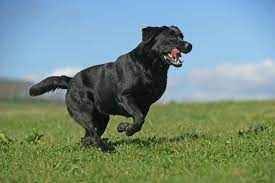The first thing most pet parents teach their dogs is the very important “sit” cue, but there are a few other obedience lessons that are equally important to master. These basic cues help dogs improve their impulse control, teach them good manners, and in some situations are literal life savers. Keep in mind, “mastery” means that your dog will respond no matter how distracting the environment, so it’s likely you’ll have to continue to brush up on the following skills throughout your dog’s lifetime. But the good news is training is an excellent way to cement your bond with your dog, and even better, it’s fun.
1. A Finished “Down.” Many pet parents accidentally leave the “down” cue incomplete, meaning they have to slap the ground in order to get their dog to move into the position. In fact, you can try a test to see if your dog is actually responding to the word “down,” or if it’s your body language that’s making him do it. Say nothing, but bend over and slap the ground as you normally do. Your dog will probably go right into a down position. Stand up straight and say the word “down” without giving any body language hints, and more than likely your dog won’t budge.
It’s easy to take this very important cue and polish it up so that you can simply say the word “down” and your dog responds. To begin, start off by luring your dog into a down as you usually do. Reward your dog with a small treat for doing it, then move a few steps to reset him for the next repetition. This time, though, don’t bring your hand all the way down to the ground as you’ve been doing. Your dog might be confused, but just hold still and wait until he slides into the down position. When he does, give him another treat, then reset by moving a few steps away. In each successive repetition, make the luring gesture with your hand less obvious, until you can stand straight up, say the word “down,” and point to the ground and your dog quickly moves into a down. Then, continue to practice this behavior in a variety of settings so that your dog generalizes it.
2. A Solid “Stay.” Some dogs learn “stay” in a very specific context, which usually involves an anxious pet parent chanting “stay, stay, stay” as they back a few baby-steps away. In order to take this cue from iffy to incredible, you need to go back to the basics. Start off by doing a “stay” in the space where you usually practice it, but say the word once instead of repeating it. Remember, eventually you’ll be putting a great deal of distance between you and your dog, and you don’t want to have to scream the word “stay” from across a field.
Continue to practice taking just a few steps away from your dog in different directions, and work up to turning your back and walking away for a few steps. Slowly increase the number of steps you can take from your dog, but throw in an easy repetition every so often. Work on this cue all over your house, and then introduce it outside as well. When your dog is reliably holding a stay both inside and out, add some real-life distractions. For example, get your dog to hold a stay while you unload the dishwasher, or have him hold a stay while you put away groceries. The goal is to incorporate the stay into your everyday life so that you can use it to keep your dog from underfoot, and more importantly, keep him safe.
3. A Trustworthy Recall. While it’s easy to teach your dog to come when called in controlled circumstances, getting a strong response in real-life situations requires dedication and a strong history of positive associations. Many dogs learn that coming when called means the fun is ending, and instead of running joyfully to their people, they opt to ignore the cue. If your dog has a history of “blowing off” your recall cue, you can build a stronger response with a brand new, baggage-free word.
Pick a neutral word that you haven’t been using, like “here,” and practice using it in the house when you’re positive your dog will respond to it. Say the word “here” once, whistle or clap to encourage your dog to run to you, and then give your dog an extra-special treat like chicken or cheese when he’s right in front of you. And don’t forget the praise! Get some friends or family to help out and practice this in different rooms in your house, until your dog is reliably running to you every time he hears the new word. Remember to keep the association positive—never call your dog to you to punish him.
Once your dog is responding reliably in the house, take it on the road. Move out to your yard to practice with your dog, always giving him a fantastic reward and lots of praise, until his response to the word “here” is reflexive and speedy. A reliable recall requires ongoing practice, so continue to give your dog periodic surprise rewards and tons of praise when you call him to you. Doing so will help your dog understand that coming to you when you call always means something fantastic is going to happen.
4. An Anti-Jump Cue. Jumping up on guests is one of the most common pet parent complaints. It’s tough to keep dogs from jumping, because they learn very early on that jumping up works to get attention. (And it doesn’t matter if it’s angry attention!) Couple that history with the fact that dogs ears seems to fuse shut when they’re excited, and you have the recipe for a dedicated jumper. However, there’s a simple way to use a dog’s tendency to focus on body language to teach an automatic sit, even when meeting a new friend. Even better, you can get your friends and family, from small children to senior citizens, to perform the cue to encourage your dog to sit instead of jump.
The cue itself is straightforward and easy to communicate: Stand up straight and cross your arms. To begin teaching it, load up on tasty treats and bring your dog to a quiet room. Move around the room, then come to a stop. Your dog will probably move into a sit automatically since he probably knows you have treats. The second his bottom hits the ground, say “yes!” and hand over a goody. Repeat the process a number of times, moving around your house to different rooms. Spend extra time working with your dog in the foyer where guests congregate.
Then, try the cue with friends. Ask someone to approach your dog and tell them to cross their arms. Your dog might pause for a moment, but if you’ve done enough foundation work, he’ll probably go into a sit. Celebrate the victory with a treat. The arm-cross sit is a powerful but simple training cue, and a great way to show off your dog’s good manners.





























